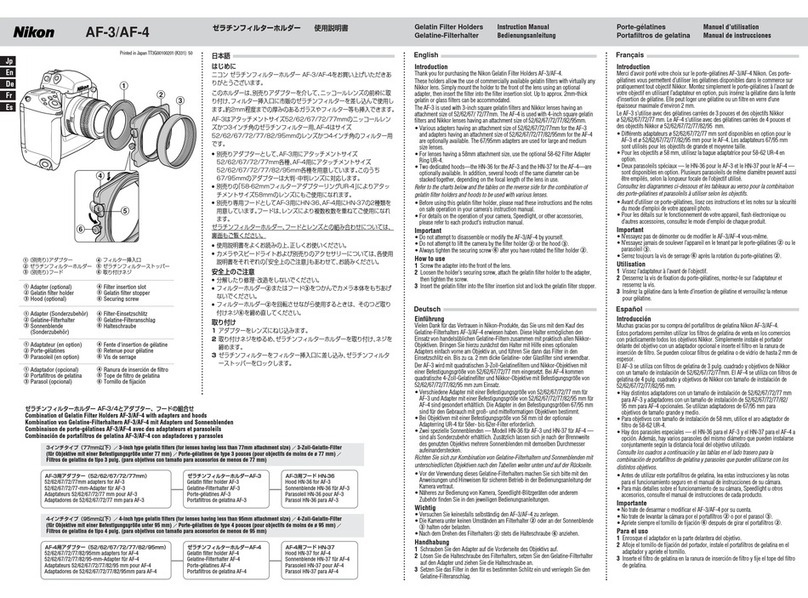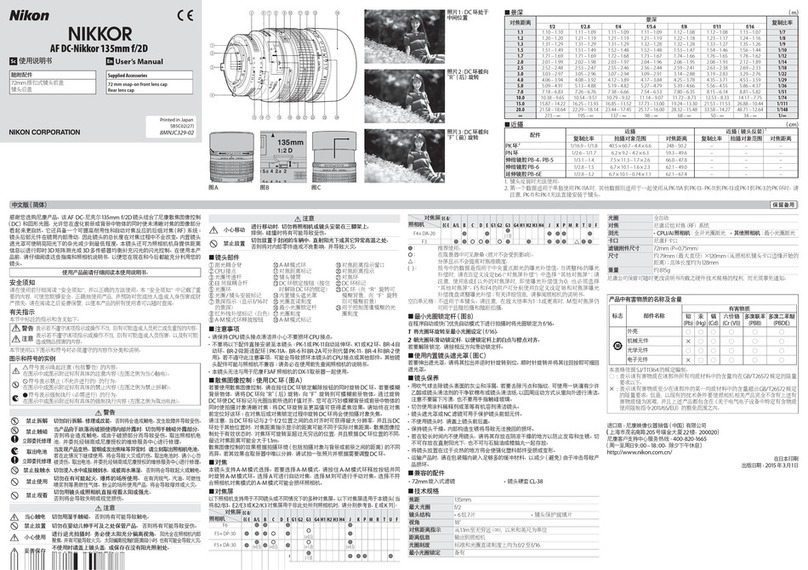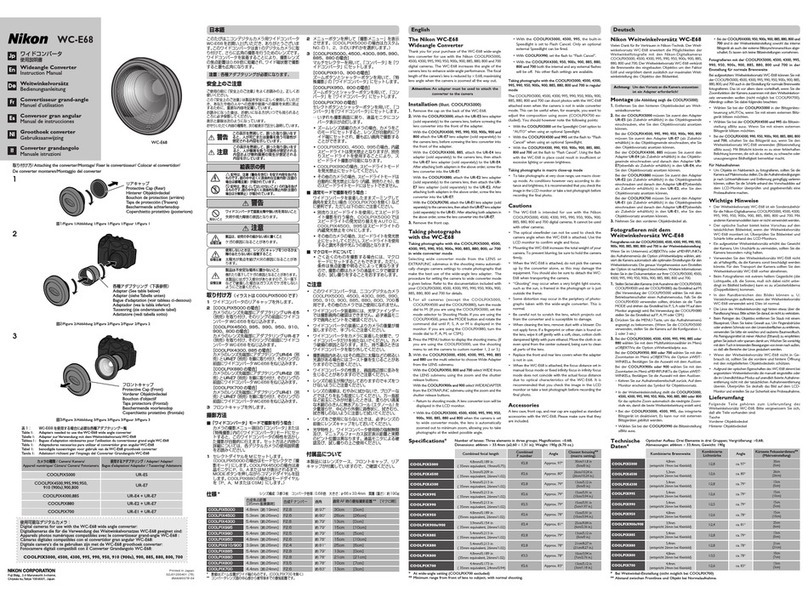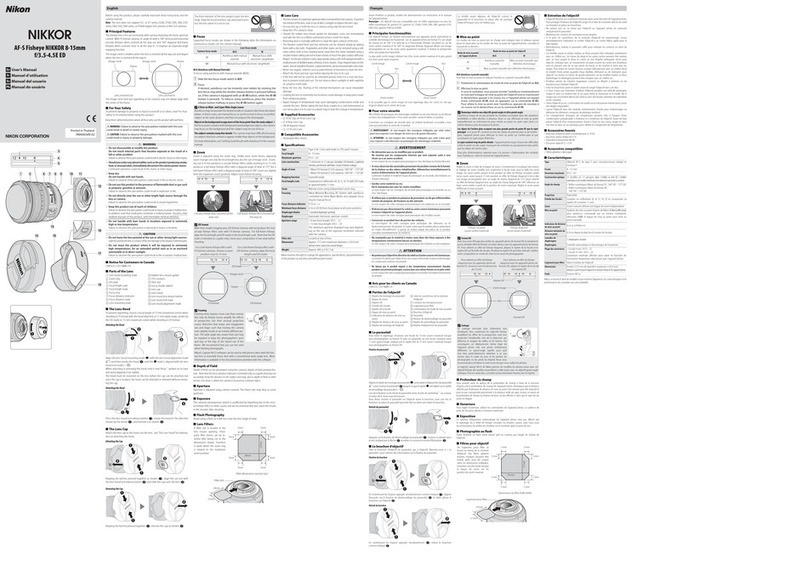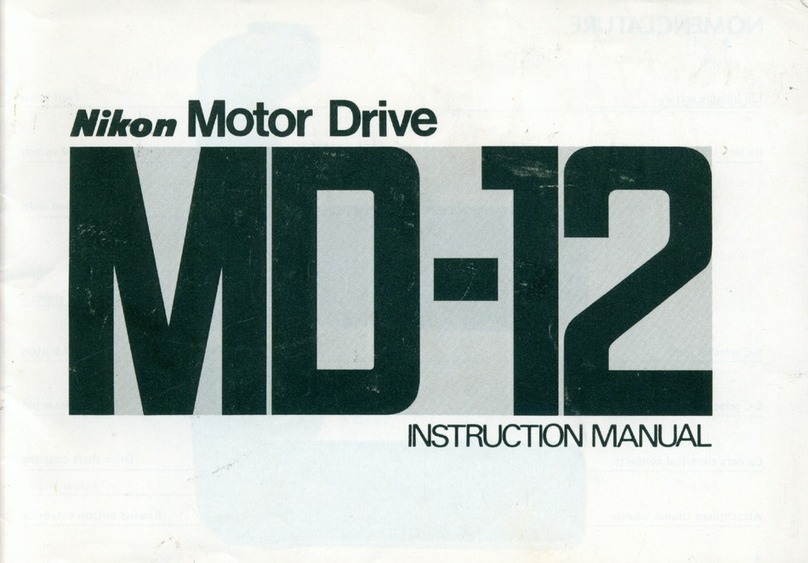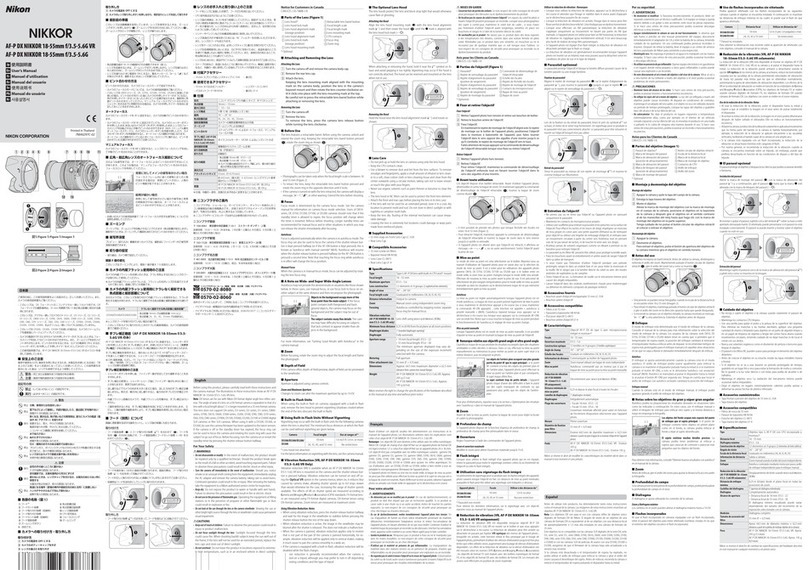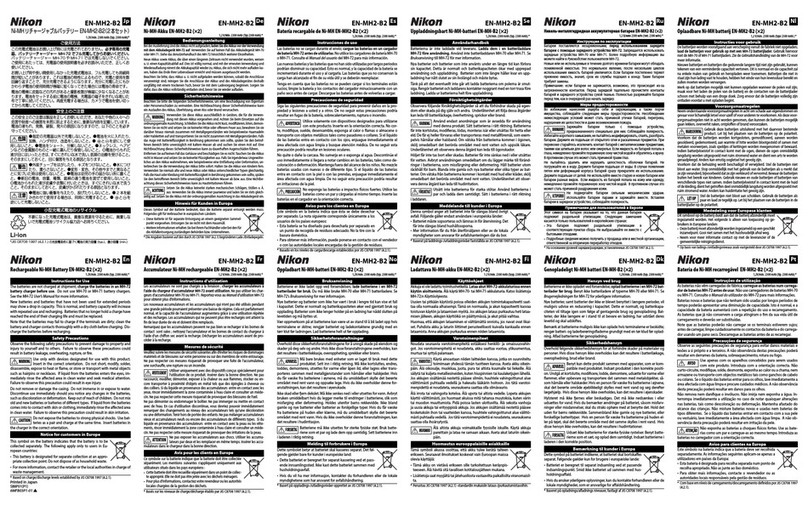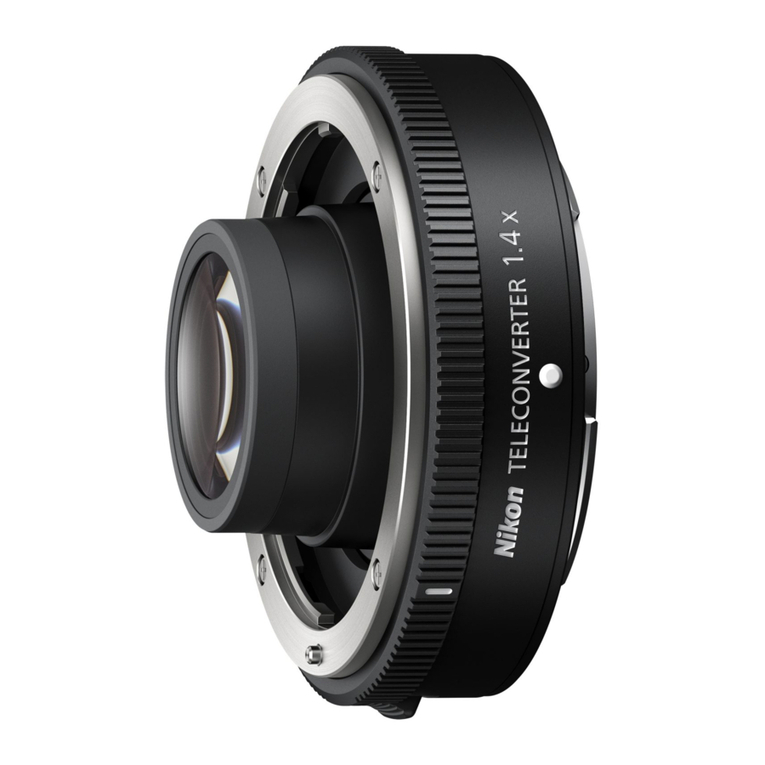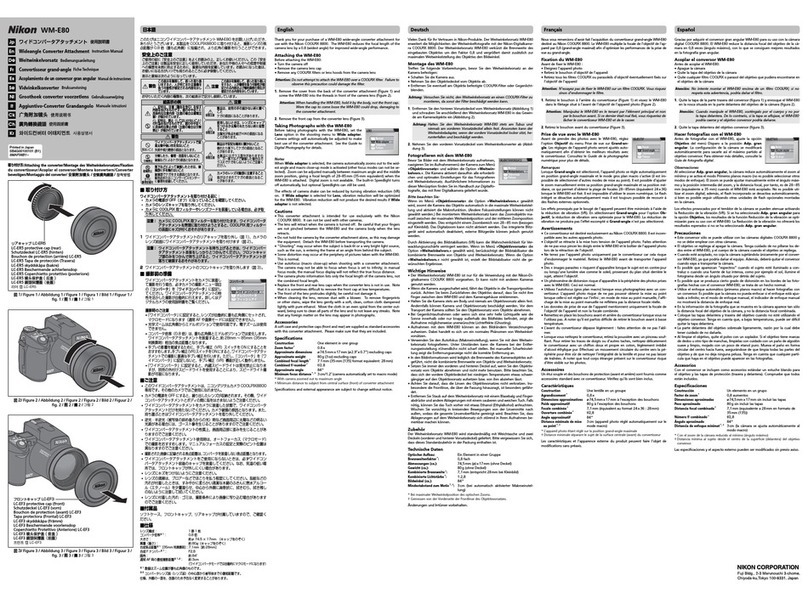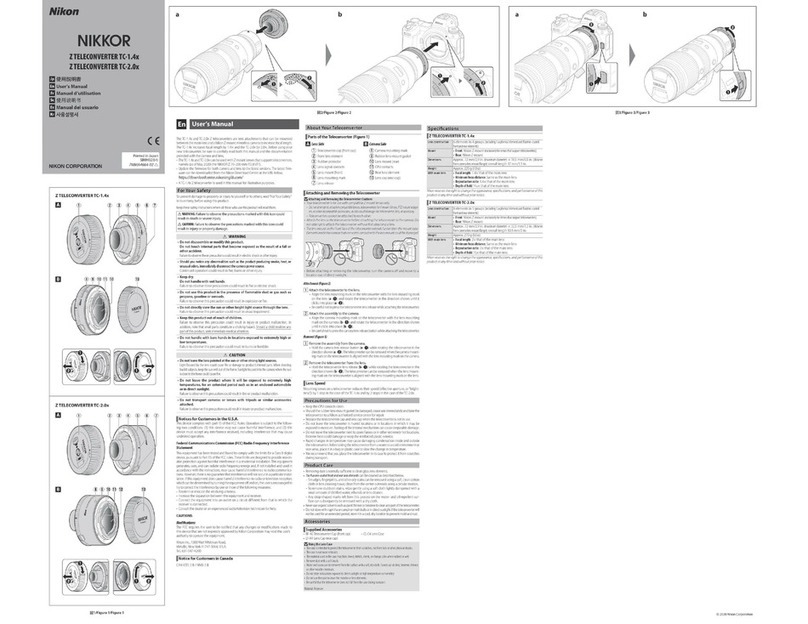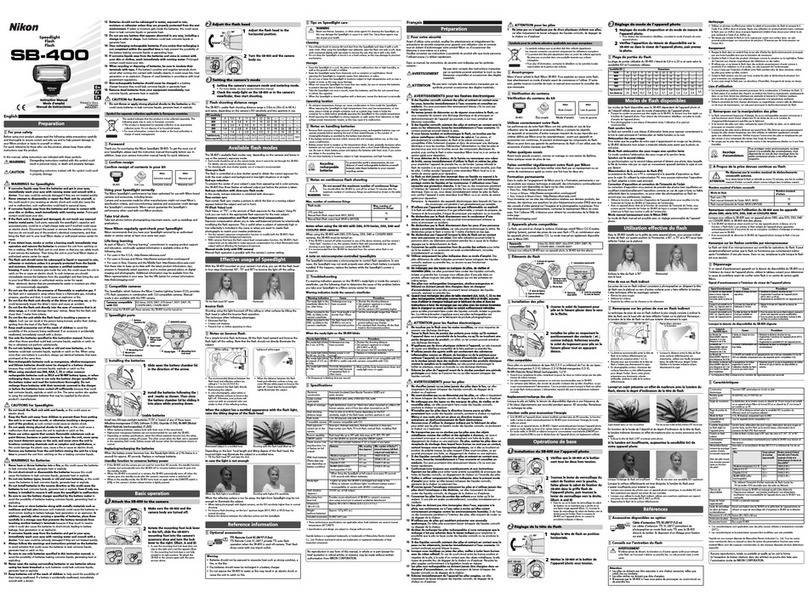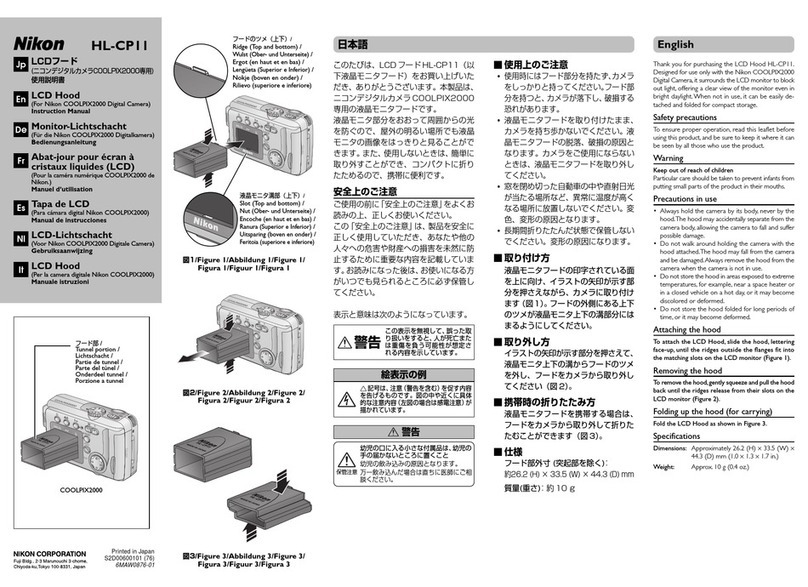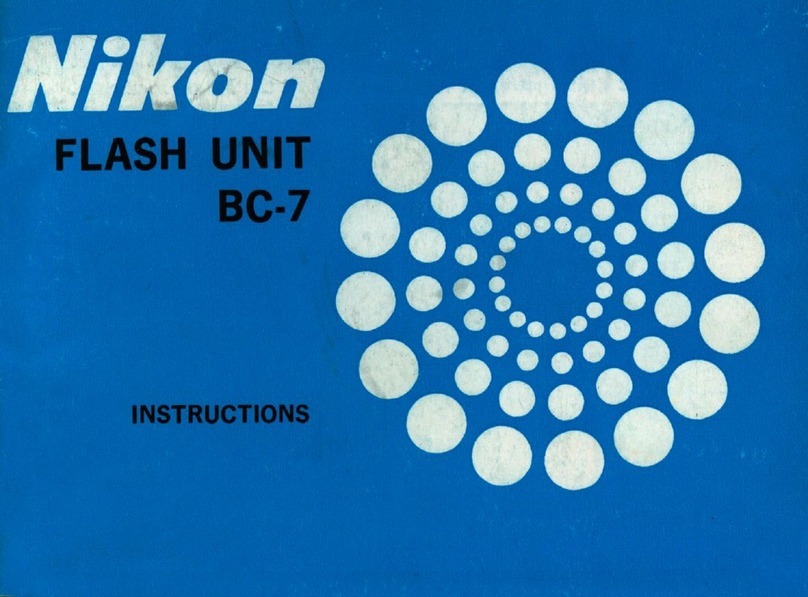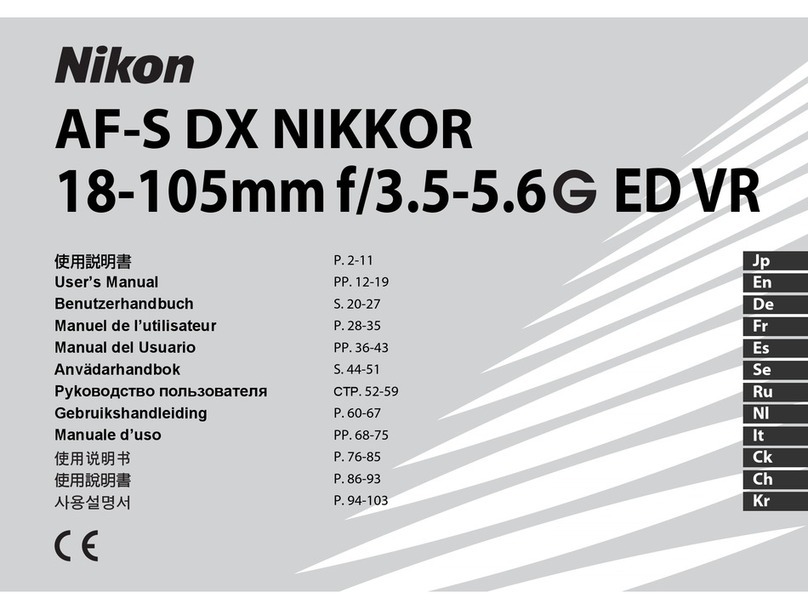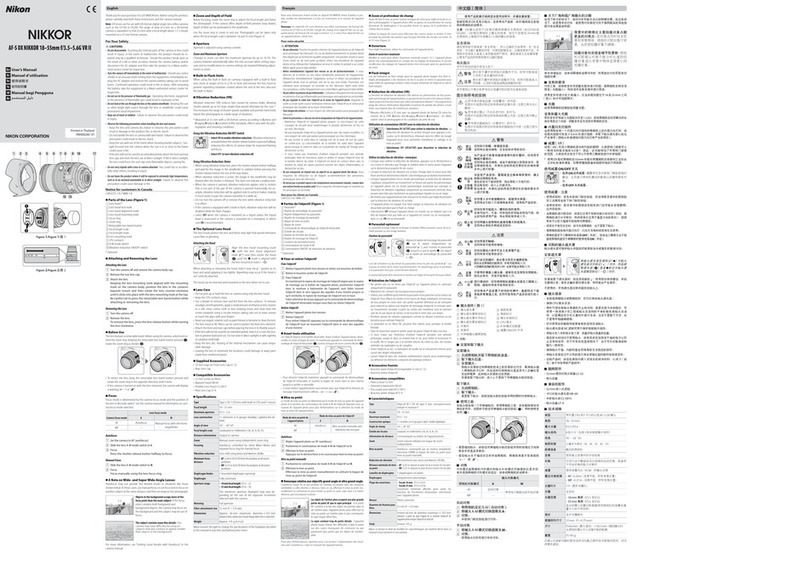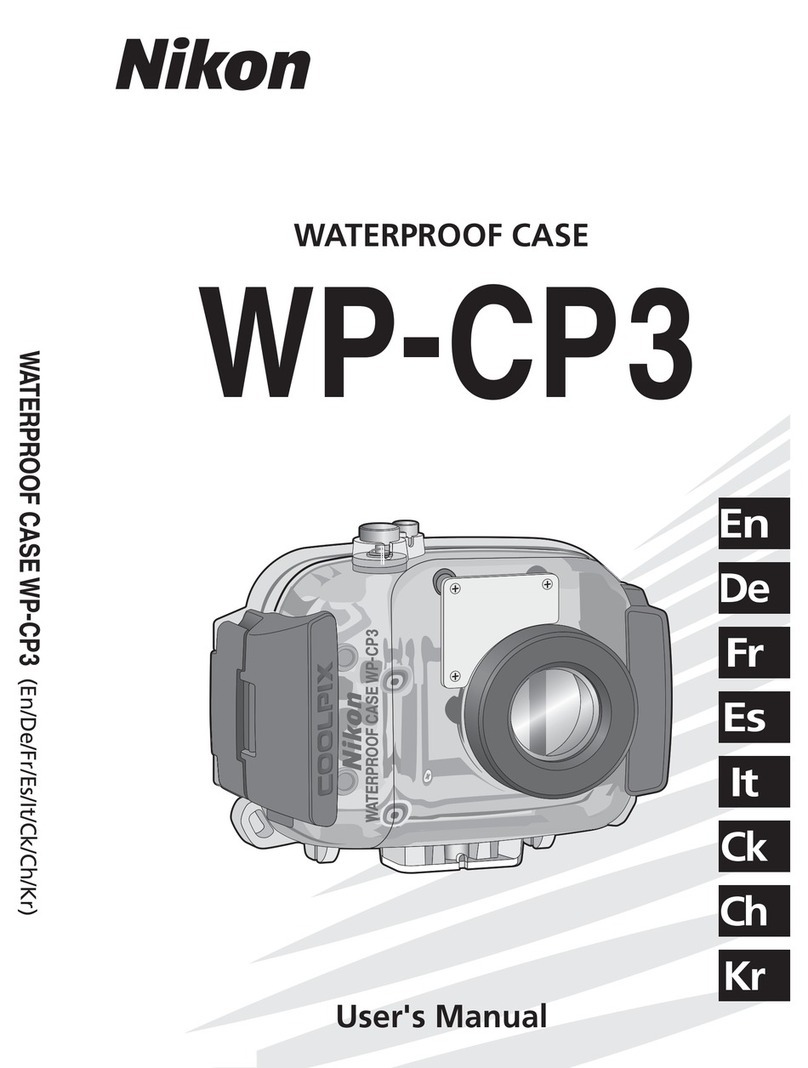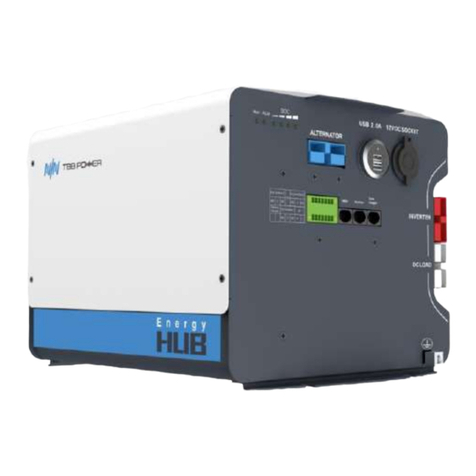
©1993 Nikon Corporation
English
■
Depth of Field (Metric)
(m)
Focus
distance
Depth of eld
Reproduction
ratio
2.8
4
5.6
8
11
16
22
0.25 0.243 – 0.258 0.24 – 0.262 0.236 – 0.267 0.23 – 0.276 0.224 – 0.288 0.215 – 0.312 0.206 – 0.35
1/10
0.3 0.287 – 0.315 0.281 – 0.323 0.275 – 0.333 0.266 – 0.351 0.256 – 0.377 0.241 – 0.434 0.227 – 0.543
1/14
0.4 0.37 – 0.437 0.359 – 0.456 0.346 – 0.484 0.328 – 0.536 0.308 – 0.623 0.283 – 0.882 0.259 – 1.988
1/20
0.5 0.448 – 0.569 0.43 – 0.607 0.408 – 0.667 0.38 – 0.789 0.351 – 1.04 0.314 – 2.45 0.282 – ∞
1/26
0.7 0.59 – 0.873 0.554 – 0.981 0.513 – 1.183 0.464 – 1.742 0.416 – 4.678 0.359 – ∞ 0.313 – ∞
1/39
10.772 – 1.46 0.705 – 1.83 0.635 – 2.85 0.555 – 21.01 0.482 – ∞ 0.402 – ∞ 0.34 – ∞
1/58
∞2.72 – ∞ 1.93 – ∞ 1.4 – ∞ 1.01 – ∞ 0.76 – ∞ 0.55 – ∞ 0.42– ∞
1/∞
Thank you for purchasing a Nikon product. The AF Fisheye-Nikkor 16mm f/2.8D lens supplies dis-
tance information to the camera body for instantaneous 3D matrix metering or 3D multi-sensor
balanced ll-ash ash control. It has a 180° diagonal angle of view for a true sheye eect, but,
unlike other Nikkor sheye lenses, it is designed to produce images that ll the entire frame, just
like those produced by conventional lenses. In addition to an L37C UV lter for normal use, it
comes with O56, A2, and B2 rear-mounted lters that can be quickly swapped in and out thanks
to their bayonet mounts. Before using this product, please carefully read both these instructions
and the camera manual so you get the maximum value from your lens now and for years to come.
■
For Your Safety
A
CAUTIONS
• Do not disassemble. Touching the internal parts of the camera or lens could result in injury. In the event of
malfunction, the product should be repaired only by a qualified technician. Should the product break
open as the result of a fall or other accident, remove the camera battery and/or disconnect the AC adapter
and then take the product to a Nikon-authorized service center for inspection.
• Turn the camera o immediately in the event of malfunction. Should you notice smoke or an unusual smell com-
ing from the equipment, immediately unplug the AC adapter and remove the camera battery, taking care
to avoid burns. Continued operation could result in fire or injury. After removing or disconnecting the
power source, take the equipment to a Nikon-authorized service center for inspection.
• Do not use in the presence of ammable gas. Operating electronic equipment in the presence of flammable gas
could result in explosion or fire.
• Do not look at the sun through the lens or the camera viewnder. Viewing the sun or other bright light source
through the lens or viewfinder could cause permanent visual impairment.
• Keep out of reach of children. Particular care should be taken to prevent infants from putting the batteries or
other small parts into their mouths.
• Observe the following precautions when handling the lens and camera:
-Keep the lens and camera dry. Failure to observe this precaution could result in fire or electric shock.
-Do not handle the lens or camera with wet hands. Failure to observe this precaution could result in
electric shock.
-Keep the sun well out of the frame when shooting backlit subjects. Sunlight focused into the camera
when the sun is in or close to the frame could cause a fire.
-If the lens will not be used for an extended period, attach the front and rear lens caps and store the lens
out of direct sunlight. If left in direct sunlight, the lens could focus the sun’s rays onto flammable objects,
causing fire.
■
Parts of the Lens
qLens barrel
wMinimum aperture lock lever
eLens hood
rFocus distance indicator
tFocal length/aperture/mounting index
yInfrared compensation index (white)
uFocus distance indicator window
iFocus ring
oAperture scale
!0 Aperture indexing post
!1 Aperture-direct-readout scale
!2 CPU contacts
!3 Depth-of-eld indicators
!4 Meter coupling ridge
!5 Aperture ring
■
Notices
• Keep the CPU lens contacts clean and be careful not damage the CPU contacts.
• Do not attach the following accessories directly to the lens: PK-1 or PK-11 auto extension rings, K1 rings,
or BR-4 auto rings (the PK-11A and BR-8 can be used in place of the PK-11 and BR-4, respectively). Failure
to observe this precaution will result in damage to the CPU contacts or other parts of the lens. Other lens
accessories may not be compatible with the camera; be sure to consult the camera manual before use.
• The lens can not be used with the DX-1 viewfinder for Nikon F3AF cameras.
■
Focus
Autofocus is available with Nikon autofocus cameras; to focus manually, rotate the focus ring until
the image in the viewnder is clearly dened.
■
Focusing Screens
The cameras listed in the “Focusing Screens” table support a variety of focusing screens for use
with dierent lenses or in dierent situations. The screens listed in the table are suited for use with
this lens.
When using B2/B3, E2/E3, or K2/K3 screens with cameras not listed in this table, refer respectively
to columns B, E, or K.
Screen
Camera
EC-B/
EC-E
A/L
B
C
D
E
G1
G2
G3
G4
H1
F6
F5+ DP-30
F5+ DA-30
(+0.5)
(+0.5)
(+0.5)
(-1)
F4+ DP-20/F4+ DA-20
(-1)
(-1)
F3
Screen
Camera
H2
H3
H4
J
K
P
M
R
T
U
F
F6
F5+ DP-30
F5+ DA-30
(+0.5)
F4+ DP-20/F4+ DA-20
F3
: Recommended.
: Vignetting visible in viewfinder (photographs are not affected).
: Split-screen display does not improve focus accuracy.
( ): Figures in parentheses give the exposure compensation for center-weighted metering. Select
“Other screen” for Custom Setting b6 (“Screen comp.”) when adjusting exposure compensation
for the F6; note that with screens other than B or E,“Other screen”must be selected even when the
value for exposure compensation is 0. Users of the F5 and F4 can adjust exposure compensation
using Custom Setting 18 or the focusing screen exposure compensation dial, respectively; see the
camera manual for details.
Empty cell: Not suited to use with this lens. Note that type M screens can however be used for photomicrog-
raphy and macro photography at magnifications of 1 : 1 or higher.
■
Filters
The lens is supplied with four lters: the L37C (a UV lter), A2,B2, and O56. A lter must be attached
at all times; choose a lter according to shooting conditions. Thanks to their bayonet mounts,
exchanging these rear-mounted lters is a snap.
■
Exchanging Filters
1Rotate the current lter counterclockwise and remove it.
2Place the replacement lter on the lens, keeping the dot on its outside rim aligned with
the grove next to the mounting pin on the lens bayonet mount, and then rotate the lter
clockwise.
■
Non-TTL Metering
No exposure compensation is required with through-the-lens (TTL) metering, as the camera me-
ters exposure based on the amount of light passing through the lens. When using cameras that
do not oer TTL metering, adjust exposure as shown in the table below. Figures in parentheses
indicate the exposure compensation in f/stops.
Film
Filter
Filter factor (exposure compensation)
Filter factor (exposure compensation)
Name
Type
Sunlight
Incandescent lighting
Black-and-white/color L37C Ultraviolet 1 1
Color only A2 Light amber 1.2 (⁄) 1.2 (⁄)
B2 Light blue 1.2 (⁄) 1.2 (⁄)
Black-and-white only O56 Orange 3.5 (1⁄) 2 (1)
■
The Minimum Aperture Lock Lever (Figure A)
The Minimum Aperture Lock Lever (Figure A)
Lock aperture at f/22 when shooting in programmed auto or shutter-priority auto mode.
1. Rotate the aperture ring to the minimum aperture setting (f/22).
2. Slide the lock lever toward the aperture ring so that the white dot on the lock lever aligns
with the orange dot.
To release the lock, slide the lever in the opposite direction.
■
Composition (Figure B)
Framing shots with a sheye lens requires even more planning and thought than would be need-
ed with a conventional lens. Not only are sheye lenses prone to distortion due to their wide
angle of view, but they also squeeze objects to t in a limited area: objects near center are larger
and less distorted than those at the edges. The entire eld is pushed into the distance and spa-
tial relations are transformed, with whole new compositions revealed by the slightest change in
camera position. Care is required to prevent extraneous objects, such as the legs of a tripod or the
photographer’s hands and feet, appearing in the frame.
■
Lens Care
• Use a blower to remove dust and lint from the lens surfaces. To remove smudges and fingerprints, apply
a small amount of ethanol or lens cleaner to a soft, clean cotton cloth or lens-cleaning tissue and clean
from the center outwards using a circular motion, taking care not to leave smears or touch the glass with
your fingers.
• Never use organic solvents such as paint thinner or benzene to clean the lens.
• Attach the front and rear caps when the lens is not in use.
• Keep the lens dry. Rusting of the internal mechanism can cause irreparable damage.
• If the lens will not be used for an extended period, store it in a cool, dry location to prevent mold and rust.
Do not store in direct sunlight or with naphtha or camphor moth balls.
• Leaving the lens in extremely hot locations could damage or warp parts made from reinforced plastic.
■
Compatible Accessories
• Flexible Lens Pouch CL-0715
■
Specifications
Focal length 16 mm
Maximum aperture f/2.8
Lens construction 8 elements in 5 groups
Angle of view 180°
Focus distance indicator Graduated in meters and feet from 0.25 m (1 ft) to infinity (∞)
Distance information Output into camera
Aperture scale f/2.8 to f/22 on both standard and aperture-direct readout scales
Diaphragm Fully automatic
Metering Full aperture
Mount Nikon F mount
Filters L37C, O56, A2 and B2 (rear-mount bayonet-type)
Dimensions Approx. 63 mm (maximum diameter) × 57 mm (distance from camera lens
mount flange); overall length is approx. 68 mm
Weight Approx. 290 g (10.2 oz)
Nikon reserves the right to change the specifications of the hardware described in this manual at any time and
without prior notice.
■
A Note on Wide- and Super Wide-Angle Lenses
A Note on Wide- and Super Wide-Angle Lenses
Autofocus may not provide the desired results with wide- and super wide-angle lenses in the
following situations:
1 The subject does not ll the area enclosed by the focus brackets (Figure C).
If the focus point contains both foreground and background objects, the camera may focus on
the background and the subject may be out of focus.
2 The subject contains many ne details (Figure D).
The camera may have diculty focusing on subjects that contain many ne details or that are
lacking in contrast.
In these cases, use manual focus, or use focus lock to focus on another subject at the same dis-
tance and then recompose the photograph. For more information, see“Getting Good Results with
Autofocus”in the camera manual.
Figure A Figure B
Figure C
A far-off portrait subject at some
distance from the background
Figure D
A field of flowers
■
Depth of Field (Imperial)
Depth of Field (Imperial)
(ft)
Focus
distance
Depth of eld
Reproduction
ratio
2.8
4
5.6
8
11
16
22
0.85 9 ⁄ in. –
10 ⁄ in.
9 ⁄ in. –
10 ⁄ in.
9 ⁄ in. –
11 ⁄ in.
9 ⁄ in. –
11 ⁄ in.
8 ⁄ in. –
1 ft ⁄ in.
8 ⁄ in. –
1 ft 1 ⁄ in.
8 ⁄ in. –
1 ft 3 ⁄ in.
1/11
111 ⁄ in. –
1 ft ⁄ in.
11 ⁄ in. –
1 ft ⁄ in.
10 ⁄ in. –
1 ft 1 ⁄ in.
10 ⁄ in. –
1 ft 2 ⁄ in.
10 ⁄ in. –
1 ft 3 ⁄ in.
9 ⁄ in. –
1 ft 5 ⁄ in.
8 ⁄ in. –
1 ft 10 ⁄ in.
1/14
1.3 1 ft 1 ⁄ in.–
1 ft 4 ⁄ in.
1 ft 1 ⁄ in.–
1 ft 4 ⁄ in.
1 ft 1 ⁄ in.–
1 ft 5 ⁄ in.
1 ft ⁄ in.–
1 ft 7 ⁄ in.
11 ⁄ in. –
1 ft 10 ⁄ in.
10 ⁄ in. –
2 ft 6 in.
9 ⁄ in. –
4 ft 7 ⁄ in.
1/19
1.5 1 ft 4 ⁄ in.–
1 ft 8 ⁄ in.
1 ft 3 ⁄ in.–
1 ft 9 ⁄ in.
1 ft 3 in.–
1 ft 10 ⁄ in.
1 ft 2 ⁄ in.–
2 ft 2 ⁄ in.
1 ft 1 ⁄ in.–
2 ft 8 ⁄ in.
11 ⁄ in. –
4 ft 9 ⁄ in.
10 ⁄ in. –
∞
1/24
21 ft 8 ⁄ in.–
2 ft 4 ⁄ in.
1 ft 7 ⁄ in.–
2 ft 7 ⁄ in.
1 ft 6 ⁄ in.–
3 ft ⁄ in.
1 ft 4 ⁄ in.–
3 ft 11 ⁄ in.
1 ft 3 ⁄ in.–
6 ft 7 ⁄ in.
1 ft 1 ⁄ in.–
∞
11 ⁄ in. –
∞
1/33
32 ft 4 ⁄ in.–
4 ft 2 ⁄ in.
2 ft 2 ⁄ in.–
5 ft ⁄ in.
1 ft 11 ⁄ in. –
7 ft 1 ⁄ in.
1 ft 8 ⁄ in.–
20 ft 1 ⁄ in.
1 ft 6 ⁄ in.–
∞
1 ft 3 ⁄ in.–
∞
1 ft 1 ⁄ in.–
∞
1/53
53 ft 4 ⁄ in.–
10 ft 4 in.
2 ft 11 ⁄ in.–
20 ft 1 in.
2 ft 6 ⁄ in.–
∞
2 ft 1 ⁄ in.–
∞
1 ft 9 ⁄ in.–
∞
1 ft 5 ⁄ in.–
∞
1 ft 2 ⁄ in.–
∞
1/92
∞8 ft 11 in.–
∞
6 ft 3 ⁄ in.–
∞
4 ft 7 ⁄ in.–
∞
3 ft 3 ⁄ in.–
∞
2 ft 5 ⁄ in.–
∞
1 ft 9 ⁄ in.–
∞
1 ft 4 ⁄ in.–
∞
1/∞
